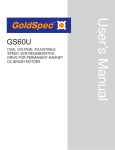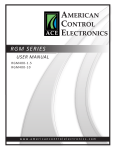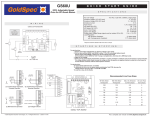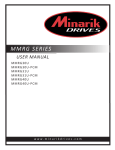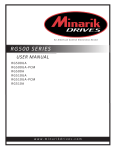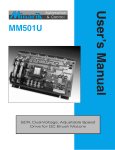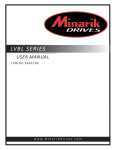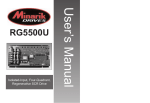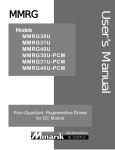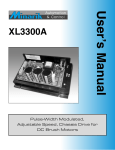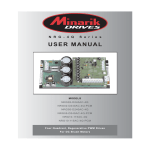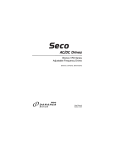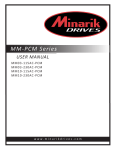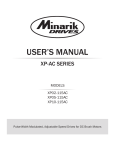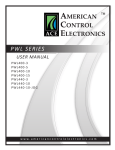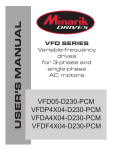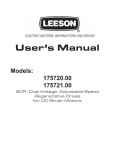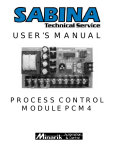Download User Manual - Galco Industrial Electronics
Transcript
250-0324r4.qxp 8/22/2005 1:17 PM Page a RG60U RG61U RG60U-PCM RG61U-PCM Dual Voltage, Adjustable Speed, SCR Regenerative Drive for Permanent Magnet DC Brush Motors User’s Manual RG60U Series 250-0250r1_readers.qxd 12/2/2005 10:23 AM Page B Copyright © 2009 by Minarik Drives All rights reserved. No part of this manual may be reproduced or transmitted in any form without written permission from Minarik Drives. The information and technical data in this manual are subject to change without notice. Minarik Drives makes no warranty of any kind with respect to this material, including, but not limited to, the implied warranties of its merchantability and fitness for a given purpose. Minarik Drives assumes no responsibility for any errors that may appear in this manual and makes no commitment to update or to keep current the information in this manual. Printed in the United States of America. 250-0324r4.qxp 8/22/2005 1:17 PM Page i i Safety Warnings • This symbol denotes an important safety tip or warning. SHOCK HAZARD AVOID HEAT KEE DR OID ATION Please read these instructions carefully before performing any of the procedures contained in this manual. • DO NOT INSTALL, REMOVE, OR REWIRE THIS EQUIPMENT WITH POWER APPLIED. Have a qualified electrical technician install, adjust and service this equipment. Follow the National Electrical Code and all other applicable electrical and safety codes, including the provisions of the Occupational Safety and Health Act (OSHA), when installing equipment. • Reduce the chance of an electrical fire, shock, or explosion by proper grounding, over-current protection, thermal protection, and enclosure. Follow sound maintenance procedures. It is possible for a drive to run at full speed as a result of a component failure. Minarik strongly recommends the installation of a master switch in the main power input to stop the drive in an emergency. Circuit potentials are at 115 VAC or 230 VAC above earth ground. Avoid direct contact with the printed circuit board or with circuit elements to prevent the risk of serious injury or fatality. Use a non-metallic screwdriver for adjusting the calibration trimpots. Use approved personal protective equipment and insulated tools if working on this drive with power applied. 250-0324r4.qxp 8/22/2005 1:17 PM Page ii ii Contents Regenerative Drives . . . . . . . . . . . . . . . . . . . . . . . . . . . . . . . . . . . . . . .v Specifications . . . . . . . . . . . . . . . . . . . . . . . . . . . . . . . . . . . . . . . . . . . . .1 Dimensions . . . . . . . . . . . . . . . . . . . . . . . . . . . . . . . . . . . . . . . . . . . . . . .2 Installation . . . . . . . . . . . . . . . . . . . . . . . . . . . . . . . . . . . . . . . . . . . . . . .4 Mounting . . . . . . . . . . . . . . . . . . . . . . . . . . . . . . . . . . . . . . . . . . . . . . .4 Wiring . . . . . . . . . . . . . . . . . . . . . . . . . . . . . . . . . . . . . . . . . . . . . . . . . .5 Shielding guidelines . . . . . . . . . . . . . . . . . . . . . . . . . . . . . . . . . . . . .6 Heat sinking . . . . . . . . . . . . . . . . . . . . . . . . . . . . . . . . . . . . . . . . . . . .7 Line fusing . . . . . . . . . . . . . . . . . . . . . . . . . . . . . . . . . . . . . . . . . . . . .7 Speed adjust potentiometer . . . . . . . . . . . . . . . . . . . . . . . . . . . . . . . . .9 Connections . . . . . . . . . . . . . . . . . . . . . . . . . . . . . . . . . . . . . . . . . . . .10 Power, fuse and motor connections . . . . . . . . . . . . . . . . . . . . . . .11 Voltage follower (isolated signal) . . . . . . . . . . . . . . . . . . . . . . . . . . .16 Line voltage switches . . . . . . . . . . . . . . . . . . . . . . . . . . . . . . . . . . . .17 Armature voltage switch . . . . . . . . . . . . . . . . . . . . . . . . . . . . . . . . . .18 Feedback selector switch . . . . . . . . . . . . . . . . . . . . . . . . . . . . . . . . .18 Voltage or Current Follower (non-isolated signal, -PCM models) . .19 Polarity reversal switch (-PCM models) . . . . . . . . . . . . . . . . . . . . . .19 Operation . . . . . . . . . . . . . . . . . . . . . . . . . . . . . . . . . . . . . . . . . . . . . . .21 Before applying power: . . . . . . . . . . . . . . . . . . . . . . . . . . . . . . . . . . .21 Startup and shutdown . . . . . . . . . . . . . . . . . . . . . . . . . . . . . . . . . . . .22 To start the drive: . . . . . . . . . . . . . . . . . . . . . . . . . . . . . . . . . . . . .22 Starting and Stopping Methods . . . . . . . . . . . . . . . . . . . . . . . . . . . . .23 Automatic restart upon power restoration . . . . . . . . . . . . . . . . . .23 Decelerate to a stop . . . . . . . . . . . . . . . . . . . . . . . . . . . . . . . . . . .24 Coast to a stop . . . . . . . . . . . . . . . . . . . . . . . . . . . . . . . . . . . . . . .25 Regenerative brake . . . . . . . . . . . . . . . . . . . . . . . . . . . . . . . . . . .25 Invert Inhibit and Invert Enable . . . . . . . . . . . . . . . . . . . . . . . . . . .26 250-0324r4.qxp 8/22/2005 1:17 PM Page iii iii Calibration . . . . . . . . . . . . . . . . . . . . . . . . . . . . . . . . . . . . . . . . . . . . . .30 MINIMUM SPEED (MIN SPD) . . . . . . . . . . . . . . . . . . . . . . . . . . . . . .32 MAXIMUM SPEED (MAX SPD) . . . . . . . . . . . . . . . . . . . . . . . . . . . .32 FORWARD TORQUE (FWD TQ) . . . . . . . . . . . . . . . . . . . . . . . . . . . .33 REVERSE TORQUE (REV TQ) . . . . . . . . . . . . . . . . . . . . . . . . . . . . .34 IR COMPENSATION (IR COMP) . . . . . . . . . . . . . . . . . . . . . . . . . . .35 FORWARD ACCELERATION (FWD ACC) . . . . . . . . . . . . . . . . . . . .36 REVERSE ACCELERATION (REV ACC) . . . . . . . . . . . . . . . . . . . . .36 DEADBAND (DB) . . . . . . . . . . . . . . . . . . . . . . . . . . . . . . . . . . . . . . .37 TACH GENERATOR (TACH) . . . . . . . . . . . . . . . . . . . . . . . . . . . . . .38 MAX (RG60U-PCM isolation card) . . . . . . . . . . . . . . . . . . . . . . . . . .40 OFFSET (RG60U-PCM isolation card) . . . . . . . . . . . . . . . . . . . . . . .41 Application Notes . . . . . . . . . . . . . . . . . . . . . . . . . . . . . . . . . . . . . . . .42 Connections to Minarik DLC600 . . . . . . . . . . . . . . . . . . . . . . . . . . . .42 FWD-REV switch . . . . . . . . . . . . . . . . . . . . . . . . . . . . . . . . . . . . . . .43 FWD-STOP-REV switch . . . . . . . . . . . . . . . . . . . . . . . . . . . . . . . . . .44 Independent Adjustable Speeds . . . . . . . . . . . . . . . . . . . . . . . . . . .45 Independent forward and reverse speeds . . . . . . . . . . . . . . . . . . . .46 Independent forward and reverse speeds with FWD-STOP-REV switch . . . . . . . . . . . . . . . . . . . . . . . . . . . . . . . . . . . . . . . . . . . . . . . .47 Troubleshooting . . . . . . . . . . . . . . . . . . . . . . . . . . . . . . . . . . . . . . . . .48 Before applying power . . . . . . . . . . . . . . . . . . . . . . . . . . . . . . . . . . .48 Replacement Parts . . . . . . . . . . . . . . . . . . . . . . . . . . . . . . . . . . . . . .52 Unconditional Warranty . . . . . . . . . . . . . . . . . . . . . .inside back cover Tables Table 1. Recommended Line Fuse Sizes . . . . . . . . . . . . . . . . . . . . . . .8 Table 2. Replacement Parts . . . . . . . . . . . . . . . . . . . . . . . . . . . . . . . .52 250-0324r4.qxp 8/22/2005 1:17 PM Page iv iv Illustrations Figure Figure Figure Figure Figure Figure Figure Figure Figure Figure Figure Figure Figure Figure Figure Figure Figure Figure Figure Figure Figure Figure Figure Figure Figure Figure 1. Four Quadrant Operation . . . . . . . . . . . . . . . . . . . . . . . . . . . .vi 2. RG60U/RG61U Dimensions . . . . . . . . . . . . . . . . . . . . . . . . . .2 3. RG60U-PCM/RG61U-PCM Dimensions . . . . . . . . . . . . . . . . .3 4. Speed Adjust Potentiometer . . . . . . . . . . . . . . . . . . . . . . . . . .9 5. Screw Terminal Block . . . . . . . . . . . . . . . . . . . . . . . . . . . . . .10 6. Cage-Clamp Terminal Block . . . . . . . . . . . . . . . . . . . . . . . . .10 7. Power and Motor Connections (Bottom Board) . . . . . . . . . .13 8. Speed Adjust Potentiometer Connections . . . . . . . . . . . . . .15 9. Voltage Follower Connection . . . . . . . . . . . . . . . . . . . . . . . . .16 10. Line Voltage Switches (bottom board) . . . . . . . . . . . . . . . .17 11. Armature Voltage and Feedback Selector Switch Locations (top board) . . . . . . . . . . . . . . . . .18 12. RG-60U-PCM connections and jumper settings . . . . . . . . .20 13. RUN/STOP Switch . . . . . . . . . . . . . . . . . . . . . . . . . . . . . . .24 14. INHIBIT / ENABLE Terminal TB503 and JP502 Locations . . . . . . . . . . . . . . . . . . . . . . . . . . . . . .27 15. INHIBIT Settings . . . . . . . . . . . . . . . . . . . . . . . . . . . . . . . . .28 16. ENABLE Settings . . . . . . . . . . . . . . . . . . . . . . . . . . . . . . . .29 17. RG60U Calibration Trimpot Locations . . . . . . . . . . . . . . . . .31 18. Deadband Settings . . . . . . . . . . . . . . . . . . . . . . . . . . . . . . .37 19. Typical FWD TQ, REV TQ, and IR COMP Trimpot Settings . . . . . . . . . . . . . . . . . . . . . . . . .39 20. PCM Calibration Trimpot Locations . . . . . . . . . . . . . . . . . . .40 21. RG60U Connections to DLC600 . . . . . . . . . . . . . . . . . . . . .42 22. Forward-Reverse Switch . . . . . . . . . . . . . . . . . . . . . . . . . . .43 23. Forward-Stop-Reverse Switch . . . . . . . . . . . . . . . . . . . . . . .44 24. Independent Adjustable Speeds (Forward Direction) . . . . .45 25. Independent Forward and Reverse Speeds . . . . . . . . . . .46 26. Independent Forward and Reverse Speeds with a Forward-Stop-Reverse Switch . . . . . . . . . . . . . . . . . . . . .47 250-0324r4.qxp 8/22/2005 1:17 PM Page v v Regenerative Drives Most non-regenerative, variable speed, DC drives control current flow to a motor in one direction. The direction of current flow is the same direction as the motor rotation. Non-regenerative drives operate in Quadrant 1, and also in Quadrant 3 if the drive is reversible (see Figure 1, page VI). Motors must stop before reversing direction. Unless dynamic braking is used, nonregenerative drives cannot decelerate a load faster than coasting to a lower speed. Regenerative drives operate in two additional quadrants: Quadrant 2 and Quadrant 4. In these quadrants, motor torque is in the opposite direction of motor rotation. This allows regenerative drives to reverse a motor without contactors or switches, to control an overhauling load, and to decelerate a load faster than it would take to coast to a lower speed. 250-0324r4.qxp vi 8/22/2005 1:17 PM Page vi Regenerative Drives Quadrant II Quadrant I Quadrant III Quadrant IV MOTOR ROTATION MOTOR TORQUE NOTE: ARROWS IN SAME DIRECTION = MOTOR ACTION ARROWS IN OPPOSITE DIRECTION = REGENERATIVE ACTION Figure 1. Four Quadrant Operation 250-0324r4.qxp 8/22/2005 1:17 PM Page 1 1 Specifications Model Armature Current Range (ADC) Armature Horsepower RG60U, RG60U-PCM RG61U, RG61U-PCM Voltage Range (VDC) 5.0* 1/4 - 1/2* 0 - 90 5.0** 1/4 – 1** 0 – 180 1.5 1/20 - 1/8 0 - 90 1.5 1/10 - 1/4 0 - 180 * Max. Armature Current = 10 ADC and Max. Horsepower = 1 hp when mounted to heat sink kit part number 223-0159. ** Max. Armature Current = 10 ADC and Max. Horsepower = 2 hp when mounted to heat sink kit part number 223-0159. AC Line Voltage 115 VAC / 230 VAC, ±10%, 50/60 Hz, single phase Form Factor 1.37 at base speed Acceleration Time Range 0.5 – 6 seconds Deceleration Time Range 0.5 – 6 seconds Analog Input Voltage Range (without -PCM option, signal must be isolated; S0 to S2) Input Impedance (S0 to S2) 0 to +/- 10 VDC 30 kohms Load Regulation with Armature Feedback with Tachogenerator Feedback Vibration 1% base speed 0.1% base speed 0.5G max. (20–50 Hz) 0.1G max. (> 50 Hz) Ambient Temperature Range Weight 10°C – 55°C 1.1 lb 250-0324r4.qxp 8/22/2005 1:17 PM Page 2 2 Dimensions SW503 C502 MAX SPD 2.55 [65] IL501 IL502 IC502 IC503 TB503 A2 0.19 [5] INHIBIT LIMIT FWD REV FWD TQ A1 C501 ENABLE GND REV TQ Y501 L1 INVERT ENABLE TB502 3.70 [94] C503 IC501 INVERT INHIBIT IR COMP IC504 JP502 C504 REV ACC L2 FEEDBACK ARM-TACH SW504 ARMATURE 90-180 FWD ACC DB MIN SPD IL503 S0 S1 S2 S3 +15V -15V RB2 T1 T2 0.71 [18] TB501 0.80 [20] RB1 POWER TACH T501 HEATSINK DIMENSIONS (optional) 6.9 x 4.4 x 1.0 1.96 [50] 0.19 [5] 1.66 [42] 3.80 [97] 4.30 [109] ALL DIMENSIONS IN INCHES [MILLIMETERS] Figure 2. RG60U/RG61U Dimensions 250-0324r4.qxp 8/22/2005 1:17 PM Page 3 Dimensions MAX OFFSET TB502 L2 A1 J502 3.70 [94] L1 IC504 GND IC505 IC503 C503 C504 T503 J501 C501 C502 -IN +IN S1 S2 S3 COM +5V DIR EN INH IC502 2.55 [65] 0.19 [5] A2 0.80 [20] IC501 IC506 0.71 [18] TB501 HEATSINK DIMENSIONS (optional) 6.9 x 4.4 x 1.0 3.03 [77] 0.19 [5] 1.96 [50] 1.66 [42] 3.80 [97] 4.30 [109] ALL DIMENSIONS IN INCHES [MILLIMETERS] Figure 3. RG60U-PCM/RG61U-PCM Dimensions 3 250-0324r4.qxp 8/22/2005 1:17 PM Page 4 4 Installation Mounting Warning Do not install, rewire, or remove this control with input power applied. Doing so may cause fire or serious injury. Make sure you have read and understood the Safety Warnings on page i before attempting installation. • Drive components are sensitive to electrostatic fields. Avoid direct contact with the circuit board. Hold drive by the chassis only. • Protect the drive from dirt, moisture, and accidental contact. • Provide sufficient room for access to the terminal block and calibration trimpots. • Mount the drive away from heat sources. Operate the drive within the specified ambient operating temperature range. • Prevent loose connections by avoiding excessive vibration of the drive. • Mount drive with its board in either a horizontal or vertical plane. Six 0.19 in. (5 mm) wide slots in the chassis accept #8 pan head screws. Fasten either the large base or the narrow flange of the chassis to the subplate. • The chassis should be earth grounded. Use a star washer beneath the head of at least one of the mounting screws to penetrate the anodized chassis surface and to reach bare metal. 250-0324r4.qxp 8/22/2005 1:17 PM Page 5 Installation 5 Wiring Warning Do not install, rewire, or remove this control with input power applied. Failure to heed this warning may result in fire, explosion, or serious injury. Circuit potentials are at 115 or 230 VAC above ground. To prevent the risk of injury or fatality, avoid direct contact with the printed circuit board or with circuit elements. Do not disconnect any of the motor leads from the drive unless power is removed or the drive is disabled. Opening any one motor lead while the drive is running may destroy the drive. • Use 18 AWG wire for speed adjust potentiometer wiring. Use 14 AWG wire for AC line (L1, L2) and motor (A1, A2) wiring. 250-0324r4.qxp 6 8/22/2005 1:17 PM Page 6 Installation Shielding guidelines Warning Under no circumstances should power and logic leads be bundled together. Induced voltage can cause unpredictable behavior in any electronic device, including motor controls. As a general rule, Minarik recommends shielding of all conductors. If it is not practical to shield power conductors, Minarik recommends shielding all logic-level leads. If shielding of all logiclevel leads is not practical, the user should twist all logic leads with themselves to minimize induced noise. It may be necessary to earth ground the shielded cable. If noise is produced by devices other than the drive, ground the shield at the drive end. If noise is generated by a device on the drive, ground the shield at the end away from the drive. Do not ground both ends of the shield. If the drive continues to pick up noise after grounding the shield, it may be necessary to add AC line filtering devices, or to mount the drive in a less noisy environment. Logic wires from other input devices, such as motion controllers and PLL velocity controllers, must be separated from power lines in the same manner as the logic I/O on this drive. 250-0324r4.qxp 8/22/2005 1:17 PM Page 7 Installation 7 Heat sinking The RG60U drive requires an additional heat sink when the continuous armature current is above 5 ADC. Use Minarik heat sink kit part number 223-0159. Use a thermally conductive heat sink compound (such as Dow Corning® 340 Heat Sink compound) between the drive chassis and the heat sink surface for optimum heat transfer. Line fusing Minarik drives should be used with fuses for protection. Use fast acting fuses rated for 250 VAC or higher. Fuse L1 only when the line voltage is 115 VAC. Fuse both L1 and L2 when the line voltage is 230 VAC. Table 1 on page 8 lists the recommended line fuse sizes. 250-0324r4.qxp 8 8/22/2005 1:17 PM Page 8 Installation Table 1. Recommended Line Fuse Sizes 90 VDC Motor Horsepower 180 VDC Motor Horsepower Max. DC Armature Current (amps) AC Line Fuse Size (amps) 1/20 1/10 0.5 3 1/15 1/8 0.8 3 1/8 1/4 1.5 5 1/6 1/3 1.75 5 1/4 1/2 2.5 8 1/3 3/4 3.5 8 1/2 1 5.0 10 3/4 1 1/2 7.5 15 1 2 10 20 Minarik Corporation offers two fuse kits: part number 050–0069 (3–8A Fuse Kit) and 050–0073 (5–20A Fuse Kit). 250-0324r4.qxp 8/22/2005 1:17 PM Page 9 Installation Speed adjust potentiometer Warning Be sure that the potentiometer tabs do not make contact with the potentiometer enclosure. Grounding the input will cause damage to the drive. Mount the speed adjust potentiometer through a 0.38 in. (10 mm) hole with the hardware provided (Figure 4). Install the circular insulating disk between the panel and the 10K ohm speed adjust potentiometer. Twist the speed adjust potentiometer wire to avoid picking up unwanted electrical noise. If speed adjust potentiometer wires are longer than 18 in. (46 cm), use shielded cable. Keep speed adjust potentiometer wires separate from power leads (L1, L2, A1, A2). MOUNT THROUGH A 0.38 IN. (10 MM) HOLE CW WIPER W NUT STAR WASHER SPEED ADJUST POTENTIOMETER INSULATING DISK PANEL Figure 4. Speed Adjust Potentiometer 9 250-0324r4.qxp 10 8/22/2005 1:17 PM Page 10 Installation Connections Screw terminal block Most connections to the RG60U drive are made to a screw terminal block (part number 160-0171). Using a screwdriver, turn the terminal block screw counterclockwise to open the wire clamp. Insert 18 AWG stripped wire into the wire clamp. Turn the terminal block screw clockwise to clamp the wire. Wire Clamp Screw Figure 5. Screw Terminal Block Cage-clamp terminal block Inhibit and enable connections are made to a cage-clamp terminal block. To insert a wire into the terminal block, press down on the lever arm using a small screwdriver. Insert 20 AWG stripped wire into the wire clamp in front of the terminal block. Release the lever arm to clamp the wire. Lever Arm Wire Clamp Figure 6. Cage-Clamp Terminal Block 250-0324r4.qxp 8/22/2005 1:17 PM Page 11 Installation 11 Warning Do not connect this equipment with power applied. Failure to heed this directive may result in fire or serious injury. Minarik strongly recommends the installation of a master power switch in the voltage input line, as shown in Figure 7, page 13. The switch contacts should be rated at a minimum of 200% of motor nameplate current and 250 volts. Power, fuse and motor connections Connect the power input leads, an external line fuse and a DC motor to the drive’s printed circuit board (PCB) as shown in Figure 7, page 13. Motor Minarik drives supply motor voltage from A1 and A2 terminals. It is assumed throughout this manual that, when A1 is positive with respect to A2 , the motor will rotate clockwise (CW) while looking at the output shaft protruding from the front of the motor. If this is opposite of the desired rotation, simply reverse the wiring of A1 and A2 with each other (A1 - and A2 +). Connect a DC motor to PCB terminals A1 and A2 as shown in Figure 7, page 13. Ensure that the motor voltage rating is consistent with the drive’s output voltage. 250-0324r4.qxp 12 8/22/2005 1:17 PM Page 12 Installation Power input Connect the AC line power leads to terminals L1 and L2, or to a double-throw, single-pole master power switch (recommended). Line fuse Wire an external line fuse between the stop switch (if installed) and the terminal board (Figure 7, page 13). An additional line fuse should be installed on L2 if the input voltage is 230 VAC. Refer to the line fuse table (Table 1 on page 8) for fuse ratings. FUSE* EARTH GROUND GND L2 SCR503 115-230 C502 C503 T504 SCR507 230-115 SW502 C506 SCR506 AC LINE INPUT 115 or 230 VAC C501 MOV501 T502 SCR508 TB501 C510 SCR504 T501 T505 SCR505 C507 T503 SCR501 SCR502 A2 A1 MOTOR 1:17 PM Installation Figure 7. Power and Motor Connections (Bottom Board) FUSE * NOTE ADD FUSE TO L2 WITH 230 VAC INPUT ONLY RG60U BOTTOM BOARD 8/22/2005 C509 R18 250-0324r4.qxp Page 13 13 250-0324r4.qxp 14 8/22/2005 1:17 PM Page 14 Installation Speed adjust potentiometer connections The motor can operate in one direction (unidirectional) or two directions (bidirectional) depending on how the speed adjust potentiometer is connected to the drive. Connect the speed adjust potentiometer as shown in Figure 8(a), page 15 for bidirectional operation. The motor does not operate when the wiper is in the center position. Turning the wiper clockwise (CW) from the center position causes the motor to rotate in one direction, while turning the wiper counterclockwise (CCW) causes rotation in the opposite direction. Connect the speed adjust potentiometer as shown in Figure 8(b), page 15 for unidirectional operation in the forward direction. Connect the speed adjust potentiometer as shown in Figure 8(c), page 15 for unidirectional operation in the reverse direction. Refer to the Application Notes section for additional speed adjust potentiometer connections. 250-0324r4.qxp 8/22/2005 1:17 PM Page 15 Installation 15 T2 T1 RB1 RB2 REV -15V 10K OHM SPEED POT +15V S3 S2 S1 FWD CW S0 TB501 (a) Bidirectional Operation T2 T2 T1 T1 RB1 RB1 RB2 -15V 10K OHM SPEED POT FWD +15V CW REV 10K OHM SPEED POT RB2 CW +15V -15V S3 S3 S2 S2 S1 S1 S0 S0 TB501 (b) Unidirectional Operation, Forward Direction TB501 (c) Unidirectional Operation, Reverse Direction Figure 8. Speed Adjust Potentiometer Connections 250-0324r4.qxp 16 8/22/2005 1:17 PM Page 16 Installation Voltage follower (isolated signal) The drive may be wired to follow a floating (isolated) 0 to ±10VDC signal that is isolated from earth ground instead of using a speed adjust potentiometer. Connect the signal input to S2, and the signal common to S0 (see Figure 9). T2 T1 RB1 RB2 -15V +15V S3 S2 ±10 VDC SIGNAL S1 S0 SIGNAL COMMON TB501 Figure 9. Voltage Follower Connection NOTE: For configuration of a non-isolated voltage or current signal, please refer to the -PCM option (page 19). 250-0324r4.qxp 8/22/2005 1:17 PM Page 17 Installation Line voltage switches SW501 and SW502 on the bottom board are the line voltage switches (see Figure 10). Set the switches to 115 VAC if the line voltage is 115 VAC, or to 230 VAC if the line voltage is 230 VAC. SCR504 SCR508 SCR507 SCR506 SCR505 SCR501 SCR502 L2 C510 R18 SCR503 C507 C506 T502 T505 T504 A1 T503 L1 A2 C509 GND MOV501 C502 SW501 SW502 C501 115-230 230-115 T501 Line Voltage Switches SW501 & SW502 (115 VAC or 230 VAC) Figure 10. Line Voltage Switches (bottom board) 17 250-0324r4.qxp 18 8/22/2005 1:17 PM Page 18 Installation Armature voltage switch SW504 on the top board is the armature voltage selector switch. Set SW504 to 90 if using a 90 VDC motor, or to 180 if using a 180 VDC motor. See Figure 11 for SW504 location. Feedback selector switch SW503 on the top board is the feedback selector switch. Set SW503 to TACH if using a tachogenerator; otherwise, set it to ARM for armature feedback. See Figure 11 for SW503 location. Armature Voltage Switch Feedback Selector Switch (90 VDC or 180 VDC) (ARM or TACH) INVERT C503 IC501 IC504 JP502 C504 C502 MAX SPD L2 SW503 FWD ACC REV ACC FEEDBACK ARM - TACH SW504 ARMATURE 90 - 180 Figure 11. Armature Voltage and Feedback Selector Switch Locations (top board) 250-0324r4.qxp 8/22/2005 1:17 PM Page 19 Installation 19 Voltage or Current Follower (non-isolated signal, -PCM models) PCM series drives can be configured to follow a grounded (nonisolated) voltage or current signal. To configure the drive to follow a voltage or current signal, connect the signal leads to the +IN and -IN terminals on TB501, observing proper polarity. Ensure that the following jumper terminals are properly set: J501 Settings Open pins 1 & 2 for -10 to +10 VDC signal or pot input. Jumper pins 1 & 2 for 4 to 20 mA signal input. J502 Settings Jumper pins 2 & 3 for -10 to +10 VDC signal or pot input. Jumper pins 1 & 2 for 4 to 20 mA signal input. See Figure 12, page 20 for jumper and terminal locations. Polarity reversal switch (-PCM models) To reverse the output voltage polarity without changing the input polarity, connect the DIR terminal to the +5V terminal on TB501 of the PCM board. A single-pole, single-throw switch can be used as a polarity reversal switch. Close the switch to reverse the output voltage polarity. Open the switch to return the output voltage back to its original polarity. See Figure 12, page 20 for polarity reversal switch connections. INH IC505 S2 COM INHIBIT ENABLE DIRECTION S3 IC504 IC503 IC502 1 J502 S1 +5V -10 to +10 VDC or 4 to 20 mA SPEED ADJUST SIGNAL INPUT • Open pins 1 & 2 for -10 to +10 VDC signal or pot input • Jumper pins 1 & 2 for 4 to 20 mA signal input J501 • Jumper pins 1 & 2 for 4 to 20 mA signal input • Jumper pins 2 & 3 for -10 to +10 VDC signal or pot input J502 JUMPER SETTINGS S3 S2 FWD S1 S1 S2 - IN 10K OHM SPEED ADJUST POTENTIOMETER cw TB501 UNI-DIRECTIONAL OPERATION 10K OHM SPEED ADJUST POTENTIOMETER REV cw TB501 BI-DIRECTIONAL OPERATION SPEED POTENTIOMETER CONNECTIONS Figure 12. RG-60U-PCM connections and jumper settings Note: Invert inhibit terminals must not be shorted on middle board when using RG60U-PCM Close direction switch to change directions. Close the enable to coast the motor to a stop. Close the inhibit to brake the motor to a stop. TB501 IC501 IC506 C502 T503 OFFSET C503 C501 J501 C504 MAX 1:18 PM SWITCH SETTINGS EN 8/22/2005 DIR TB502 +IN 20 -IN 250-0324r4.qxp Page 20 Installation 250-0324r4.qxp 8/22/2005 1:18 PM Page 21 21 Operation Warning Dangerous voltages exist on the drive when it is powered. BE ALERT. High voltages can cause serious or fatal injury. For your safety, use personal protective equipment (PPE) when operating this drive. Before applying power: 1. Verify that no conductive material is present on the printed circuit board. 2. Ensure that all switches and jumpers are properly set. 250-0324r4.qxp 22 8/22/2005 1:18 PM Page 22 Operation Startup and shutdown To start the drive: 1. Set the speed adjust potentiometer or reference voltage to zero speed. 2. Apply AC line voltage. 3. Slowly turn the speed adjust potentiometer clockwise or counterclockwise to rotate the motor in the forward or reverse direction. If in a voltage follower mode, slowly increase the voltage in either the positive or negative direction to rotate the motor in the forward or reverse direction. Continue until the desired speed is reached. 4. To decelerate the motor from set speed to a stop, reset the speed adjust potentiometer to zero speed, or reference voltage to zero. To coast the motor from set speed to a stop, remove AC line voltage from the drive . If the motor or drive does not perform as described, disconnect the AC line voltage immediately. Refer to the Troubleshooting section for further assistance. 250-0324r4.qxp 8/22/2005 1:18 PM Page 23 23 Starting and Stopping Methods Warning Decelerating to minimum speed, regenerative braking, or coasting to a stop is recommended for frequent starts and stops. Do not use any of these methods for emergency stopping. They may not stop a drive that is malfunctioning. Removing AC line power (both L1 and L2) is the only acceptable method for emergency stopping. For this reason, Minarik strongly recommends installing an emergency stop switch on both the L1 and L2 inputs (see Figure 7, page 13). Frequent decelerating to minimum speed or regenerative braking produces high torque. This may cause damage to motors, especially gearmotors that are not properly sized for the application Automatic restart upon power restoration All drives automatically run to set speed when power is applied and enabled. 250-0324r4.qxp 24 8/22/2005 1:18 PM Page 24 Operation Decelerate to a stop The RUN/STOP switch in Figure 13 may be used to decelerate a motor to a stop. Closing the switch between RB1 and RB2 decelerates the motor from set speed to a stop. The FWD ACC and REV ACC trimpot settings determine the rate at which the will drive decelerate to a stop and accelerate back to set speed. Set the switch to the RUN position to accelerate the motor to set speed. TB501 L2 L1 GND T2 T1 FWD ACC REV ACC LIMIT FWD REV INVERT INHIBIT ARMATURE 90-180 INVERT ENABLE C503 IC501 ENABLE TB503 FEEDBACK ARM-TACH S0 SW504 JP502 S1 S1 MAX SPD IR COMP Y501 POWER S2 S2 IC504 SW503 C501 T501 S0 IL503 +15V S3 C504 TB502 -15V S3 REV TQ IL501 IL502 RB2 +15V FWD TQ RB1 -15V DB T1 RB2 RUN MIN SPD T2 TACH TB501 RB1 STOP INHIBIT C502 IC502 IC503 A1 A2 Figure 13. RUN/STOP Switch 250-0324r4.qxp 8/22/2005 1:18 PM Page 25 Operation 25 Regenerative brake To regeneratively brake the motor, short the INHIBIT terminals on TB503. Reopening the INHIBIT terminals causes the motor to accelerate to set speed (see Figure 14, page 27 for INHIBIT terminal locations and Figure 15, page 28 for INHIBIT settings). Twist inhibit wires and separate them from other power-carrying wires or sources of electrical noise. Use shielded cable if the inhibit wires are longer than 18 in. (46 cm). If shielded cable is used, ground only one end of the shield to earth ground. Do not ground both ends of the shield. Coast to a stop To coast the motor to a stop without removing power to the drive, short the ENABLE terminals on TB503 (see Figure 14, page 27 for ENABLE terminal locations and Figure 16, page 29 for ENABLE settings). Momentarily shorting the ENABLE terminals will coast the motor to zero speed, then accelerate back to set speed. Completely shorting the ENABLE terminals will coast the motor to a complete stop. Reopening the ENABLE terminals causes the motor to accelerate to set speed. 250-0324r4.qxp 26 8/22/2005 1:18 PM Page 26 Operation Invert Inhibit and Invert Enable INVERT modes reverse the function of the INHIBIT and ENABLE terminals. Each drive is assembled with the INVERT INHIBIT and INVERT ENABLE jumper settings open (jumpers on location 1 and 4 of JP502). See Figure 14, page 27 for JP502 location. To activate the INVERT INHIBIT mode, jumper locations 1 and 2 of JP502 (see Figure 15, page 28). In INVERT INHIBIT mode, the motor will regeneratively brake when inhibit terminals are open. To accelerate the motor to set speed, close the inhibit terminals. To activate the INVERT ENABLE mode, jumper locations 3 and 4, (see Figure 16, page 29). In INVERT ENABLE mode, the motor will coast to a stop when the enable terminals are open. To accelerate the motor to set speed, close the enable terminals. 250-0324r4.qxp 8/22/2005 1:18 PM Page 27 Operation 27 INVERT INHIBIT & INVERT ENABLE Jumper Settings (JP502) SW503 C502 MAX SPD L2 A1 C501 IC502 IC503 TB503 Y501 IL501 IL502 A2 INHIBIT LIMIT FWD REV FWD TQ ENABLE GND REV TQ INVERT ENABLE TB502 L1 C503 IC501 INVERT INHIBIT IR COMP IC504 JP502 C504 REV ACC FEEDBACK ARM-TACH SW504 ARMATURE 90-180 FWD ACC DB MIN SPD IL503 S0 S1 S2 S3 +15V -15V RB2 T1 T2 TB501 RB1 POWER TACH T501 INHIBIT TERMINALS ENABLE TERMINALS Figure 14. INHIBIT / ENABLE Terminal TB503 and JP502 Locations CLOSED OPEN TB503 TB503 OPEN CLOSED MOTOR REGENERATIVELY BRAKES WHEN INHIBIT TERMINALS ARE OPENED INVERT INHIBIT MODE MOTOR REGENERATIVELY BRAKES WHEN INHIBIT TERMINALS ARE CLOSED INHIBIT MODE Figure 15. INHIBIT Settings NOTE: The RG60U will operate in normal running mode when all jumpers on JP502 and all terminals on TB503 are simultaneously opened. Likewise, it will operate in normal running mode when all jumpers and terminals are simultaneously closed. JP502 JP502 DRIVE RESPONSE SETTINGS 1:18 PM INVERT INHIBIT INVERT INHIBIT CONFIGURATION INHIBIT INHIBIT 28 8/22/2005 INHIBIT 250-0324r4.qxp Page 28 Operation CLOSED OPEN TB503 CLOSED MOTOR COASTS TO STOP WHEN ENABLE TERMINALS ARE MAINTAINED OPEN MAINTAINED OPEN INVERT ENABLE MODE MOTOR COASTS TO STOP WHEN ENABLE TERMINALS ARE MAINTAINED CLOSED MAINTAINED CLOSED ENABLE MODE Operation Figure 16. ENABLE Settings NOTE: The RG60U will operate in normal running mode when all jumpers on JP502 and all terminals on TB503 are simultaneously opened. Likewise, it will operate in normal running mode when all jumpers and terminals are simultaneously closed. JP502 OPEN TB503 D R I VE R ESPO N SE 1:18 PM INVERT ENABLE INVERT ENABLE JP502 ENABLE CONFIGURATION E N A B L E S E TITN G S 8/22/2005 ENABLE 250-0324r4.qxp Page 29 29 250-0324r4.qxp 8/22/2005 1:18 PM Page 30 30 Calibration Warning Dangerous voltages exist on the drive when it is powered. When possible, disconnect the voltage input from the drive before adjusting the trimpots. If the trimpots must be adjusted with power applied, use insulated tools and the appropriate personal protection equipment. BE ALERT. High voltages can cause serious or fatal injury. The RG60U has nine user adjustable trimpots: FWD ACC, REV ACC, MAX SPD, IR COMP, REV TQ, FWD TQ, DB, MIN SPD, and TACH. Each drive is factory calibrated to its maximum current rating. Readjust the calibration trimpot settings to accommodate lower current rated motors. All adjustments increase with clockwise rotation, (CW) and decrease with counterclockwise (CCW) rotation. Use a non-metallic screwdriver for calibration. Each trimpot is identified on the printed circuit board. See Figure 17, page 31 for RG60U calibration trimpot locations. 250-0324r4.qxp 8/22/2005 1:18 PM Page 31 Calibration 31 FWD ACC SW503 MAX SPD L2 REV TQ GND INVERT ENABLE LIMIT FWD REV FWD TQ IL501 IL502 FWD TQ C5 TB503 REV TQ Y501 L1 TB502 IR COMP C503 IC501 INVERT INHIBIT IR COMP IC504 JP502 REV ACC MAX SPD C504 FWD ACC ENABLE REV ACC FEEDBACK ARM-TACH SW504 ARMATURE 90-180 DB MIN SPD IL503 MIN SPD TACH Figure 17. RG60U Calibration Trimpot Locations S0 S1 S2 S3 +15V -15V RB2 T1 TB501 T2 TACH RB1 POWER DB T501 250-0324r4.qxp 32 8/22/2005 1:18 PM Page 32 Calibration MINIMUM SPEED (MIN SPD) The MIN SPD trimpot setting determines the minimum speed when the speed adjust potentiometer is turned full CCW. It is factory set to zero speed. The minimum speed feature applies only when the drive is operating in unidirectional mode. To calibrate MIN SPD: 1. Set the speed adjust potentiometer to full CCW. 2. Adjust the MIN SPD trimpot until the desired minimum motor speed is reached. MAXIMUM SPEED (MAX SPD) The MAX SPD trimpot setting determines the maximum forward and reverse speed. It is factory set for maximum rated motor speed. To calibrate MAX SPD: 1. Set the MAX SPD trimpot full CCW. 2. Turn the speed adjust potentiometer CW so that the motor is running at full speed. 3. Adjust the MAX SPD trimpot until the desired maximum motor speed is reached. Caution! Do not attempt to run motor above 90 VDC on 115 VAC or above 180 VDC on 230 VAC. 250-0324r4.qxp 8/22/2005 1:18 PM Page 33 Calibration 33 FORWARD TORQUE (FWD TQ) Warning Although FWD TQ can be set to 120% of motor nameplate current rating, continuous operation beyond this rating may damage the motor. If you intend to operate beyond this rating, contact your Minarik representative for assistance. The FWD TQ setting determines the maximum current limit for accelerating and driving the motor in the forward direction. It is factory set at 120% of maximum rated drive current. See Figure 19 (page 39) for typical FWD TQ calibration settings or use the following procedure to recalibrate FWD TQ: 1. With the power disconnected from the drive, connect a DC ammeter in series with the armature. 2. Set the FWD TQ trimpot to minimum (full CCW). 3. Set the speed adjust potentiometer to maximum (full CW). 4. Carefully lock the motor armature. Be sure that the motor is firmly mounted. 5. Apply line power. The motor should be stopped. 6. Slowly adjust the FWD TQ trimpot CW slowly until the armature current is 120% of motor rated armature current. 7. Set the speed adjust potentiometer to minimum. 8. Remove the power from the drive. 9. Unlock the motor shaft. 10. Remove the ammeter in series with the motor armature if it is no longer needed and re-apply power to the drive. 250-0324r4.qxp 34 8/22/2005 1:18 PM Page 34 Calibration REVERSE TORQUE (REV TQ) Warning Although REV TQ can be set to 120% of motor nameplate curren rating, continuous operation beyond this rating may damage the motor. If you intend to operate beyond this rating, contact your Minarik representative for assistance. The REV TQ setting determines the maximum current limit for accelerating and driving the motor in the reverse direction. It is factory set at 120% of maximum rated drive current. See Figure 19 (page 39) for typical REV TQ calibration settings or use the following procedure to recalibrate REV TQ: 1. With the power disconnected from the drive, connect a DC ammeter in series with the armature. 2. Set the REV TQ trimpot to minimum (full CCW). 3. Set the speed adjust potentiometer to maximum (full CW). 4. Carefully lock the motor armature. Be sure that the motor is firmly mounted. 5. Apply line power. The motor should be stopped. 6. Slowly adjust the REV TQ trimpot CW slowly until the armature current is 120% of motor rated armature current. 7. Set the speed adjust potentiometer to minimum. 8. Remove the power from the drive. 9. Unlock the motor shaft. 10. Remove the ammeter in series with the motor armature if it is no longer needed and re-apply power to the drive. 250-0324r4.qxp 8/22/2005 1:18 PM Page 35 Calibration 35 IR COMPENSATION (IR COMP) The IR COMP trimpot setting determines the degree to which motor speed is held constant as the motor load changes. It is factory set for optimum motor regulation. See Figure 19 (page 39) for typical IR COMP calibration settings or use the following procedure to recalibrate the IR COMP setting: 1. Set the IR COMP trimpot to minimum (full CCW). 2. Rotate the speed adjust potentiometer until the motor runs at mid-speed without load (for example, 900 RPM for an 1800 RPM motor). A hand held tachometer may be used to measure motor speed. 3. Load the motor armature to its full load armature current rating. The motor should slow down. 4. While keeping the load on the motor, rotate the IR COMP trimpot until the motor runs at the speed measured in step 2. If the motor oscillates (overcompensation), the IR COMP trimpot may be set too high (CW). Turn the IR COMP trimpot CCW to stabilize the motor. 5. Unload the motor. 250-0324r4.qxp 36 8/22/2005 1:18 PM Page 36 Calibration FORWARD ACCELERATION (FWD ACC) The FWD ACC setting determines the time the motor takes to ramp to either a higher speed in the forward direction or a lower speed in the reverse direction, within the limits of available torque. The FWD ACC setting is factory set for its fastest forward acceleration time. Turn the FWD ACC trimpot CW to increase the forward acceleration time, and CCW to decrease the forward acceleration time. REVERSE ACCELERATION (REV ACC) The REV ACC setting determines the time the motor takes to ramp to either a higher speed in the reverse direction or a lower speed in the forward direction, within the limits of available torque. The REV ACC setting is factory set for its fastest reverse acceleration time. Turn the REV ACC trimpot CW to increase the reverse acceleration time, and CCW to decrease the reverse acceleration time. 250-0324r4.qxp 8/22/2005 1:18 PM Page 37 Calibration 37 DEADBAND (DB) The deadband trimmer potentiometer determines the time that will elapse between the application of current in one direction before current is applied in the opposite direction. The deadband trimmer potentiometer affects the resistance that a motor has to changes in shaft position at zero speed. It does this by applying AC voltage to the motor armature. Deadband is factory calibrated with the notch at approximately the 3 o’clock position for 60 Hz AC line operation. Recalibrate the deadband with the notch at the 9 o’clock position for 50 Hz AC line operation. If you hear motor noise (humming), the deadband might be set too high. Turn the deadband trimpot CCW until the motor noise ceases. 60 Hz Applications 50 Hz Applications DB Notch Figure 18. Deadband Settings DB 250-0324r4.qxp 38 8/22/2005 1:18 PM Page 38 Calibration TACH GENERATOR (TACH) Calibrate the TACH setting only when a tachogenerator is used. The TACH setting, like the IR COMP setting, determines the degree to which motor speed is held constant as the motor load changes. To calibrate the TACH trimpot: 1. Connect the tachogenerator to T1 and T2. The polarity is positive (+) for T1 and negative (-) for T2 with the motor running in forward direction. 2. Set SW503 to ARM for armature feedback. 3. Set the speed adjust potentiometer full CW. Measure the armature voltage across A1 and A2 using a voltmeter. 4. Set the speed adjust potentiometer to 0 (zero speed). 5. Set SW503 to TACH for tachogenerator feedback. 6. Set the IR COMP trimpot to full CCW. 7. Set the TACH trimpot to full CW. 8. Apply line power. 9. Set the speed adjust potentiometer to full CW. 10. Adjust the TACH trimpot until the armature voltage is the same value as the voltage measured in step 3. Check that the tachogenerator is properly calibrated. The motor should run at the same speed when SW503 is set to either armature or tachogenerator feedback. 250-0324r4.qxp 8/22/2005 1:18 PM Page 39 Calibration 1 HP 90 VDC 10 ADC FWD TQ REV TQ IR COMP 2 HP 180 VDC 9.2 ADC FWD TQ REV TQ IR COMP 3/4 HP 90 VDC 7.6 ADC FWD TQ REV TQ IR COMP 1 HP 180 VDC 5 ADC FWD TQ REV TQ IR COMP 1/2 HP 90 VDC 5 ADC FWD TQ REV TQ IR COMP 3/4 HP 180 VDC 3.8 ADC FWD TQ REV TQ IR COMP 1/4 HP 90 VDC 2.7 ADC FWD TQ REV TQ IR COMP 39 1/2 HP 180 VDC 2.5 ADC FWD TQ REV TQ IR COMP Figure 19. Typical FWD TQ, REV TQ, and IR COMP Trimpot Settings 250-0324r4.qxp 40 8/22/2005 1:18 PM Page 40 Calibration MAX (-PCM isolation card) Determines the motor speed when the speed adjust potentiometer is turned to full CW, or voltage signal is set to maximum. It is factory set for maximum rated speed. To calibrate, set the MAX trimpot to full CCW, or voltage signal to maximum. Turn the main speed adjust potentiometer to full CW. Adjust the MAX trimpot until the desired maximum motor speed is reached. See Figure 20 for MAX trimpot location. MAX & OFFSET TRIMPOTS ON PCM BOARD MAX OFFSET TB502 J502 IC504 1 IC505 IC503 C503 C504 IC502 T503 -IN +IN S1 S2 S3 COM +5V DIR EN INH J501 C501 C502 IC501 IC506 TB501 Figure 20. PCM Calibration Trimpot Locations 250-0324r4.qxp 8/22/2005 1:18 PM Page 41 Calibration 41 OFFSET (-PCM isolation card) Warning This trimpot is set at the factory and should not need adjustment. Do not adjust this trimpot unless you are experiencing drift problems. Contact your Minarik representative before attempting adjustment. The RG60U-PCM has a factory-set offset to guarantee stability in a stopped motor. To calibrate the OFFSET trimpot: 1. Ensure that the input power is turned OFF. 2. Set the input signal to zero. 3. Set the OFFSET trimpot to the approximate midrange or 50%. Note: This is a 25-turn potentiometer. After setting the trimpot to zero full CCW, make 5 full rotations to reach midrange, or 50%. 4. Apply power and observe the motor. 5. If the motor shaft drifts, or slowly rotates with no signal applied, adjust the OFFSET trimpot until the motor shaft stops. The direction and amount of trimpot adjustment depends on the direction of the shaft rotation and connection of the motor leads. See Figure 20 on page 40 for OFFSET trimpot location. 250-0324r4.qxp 8/22/2005 1:18 PM Page 42 42 Application Notes Connections to Minarik DLC600 MODEL DLC600 INPUT 115/230 VAC, 50/60 HZ, 50 mA MINARIK CORPORATION - GLENDALE, CA 91201 www.minarikcorp.com G L1 L2 S1 S2 FIN + IN INH C INHIBIT SWITCH OPEN to RUN CLOSE to INHIBIT SIGNAL AC VOLTAGE COMMON EARTH GROUND +5 VDC OR +12 VDC 115 VAC or 230 VAC MAGNETIC PICKUP (NON-POLARIZED) OPTICAL ENCODER TB501 ON RG60U T2 T1 RB1 RB2 -15V +15V S3 S2 S1 S0 NOTE: ONLY ONE FEEDBACK DEVICE (MAGNETIC PICKUP OR OPTICAL ENCODER) MAY BE USED AT A TIME. Figure 21. RG60U Connections to DLC600 250-0324r4.qxp 8/22/2005 1:18 PM Page 43 Application Notes 43 FWD-REV switch Use a single-pole, two-position switch with a single speed adjust potentiometer to plug reverse the motor (Figure 22). POWER S2 IL503 +15V S3 LIMIT FWD REV TB502 -15V CW REV TQ IL501 IL502 RB2 FWD TQ RB1 L1 GND T1 REV DB MIN SPD T2 TACH TB501 Y501 S1 S0 T501 10K OHM SPEED ADJUST POTENTIOMETER ENABLE TB503 INHIBIT IC5 Figure 22. Forward-Reverse Switch 250-0324r4.qxp 44 8/22/2005 1:18 PM Page 44 Application Notes FWD-STOP-REV switch Use a single-pole, three-position switch with a single speed adjust potentiometer to stop a motor between reversal (Figure 23). Set the switch to the center position to decelerate the motor to a stop. S2 POWER S3 LIMIT FWD REV +15V IL503 CW TB502 -15V FWD REV TQ IL501 IL502 RB2 STOP TQ RB1 L1 GND T1 REV DB MIN SPD T2 TACH TB501 Y501 S1 S0 T501 10K OHM SPEED ADJUST POTENTIOMETER ENABLE TB5 INHIBIT IC5 Figure 23. Forward-Stop-Reverse Switch 250-0324r4.qxp 8/22/2005 1:18 PM Page 45 Application Notes 45 Independent Adjustable Speeds Connect two speed adjust potentiometers with a single-pole, two position switch to select between two independent speeds shown in the forward direction (Figure 24). The speed adjust potentiometers can be mounted at two separate operating stations. Total parallel resistance must equal 10 kohms. T1 RB1 RB2 -15V +15V CW S2 POWER S3 SPEED 2 IL503 CW S1 SPEED 1 S0 P2 20K OHM P1 20K OHM T50 Figure 24. Independent Adjustable Speeds (Forward Direction) DB MIN SPD T2 TACH TB501 250-0324r4.qxp 46 8/22/2005 1:18 PM Page 46 Application Notes Independent forward and reverse speeds Connect two speed adjust potentiometers as shown in Figure 25 to select between independent forward and reverse speeds. T1 RB1 RB2 -15V +15V CW S2 POWER S3 FWD S1 REV S0 FWD 10K OHM REV 10K OHM T50 Figure 25. Independent Forward and Reverse Speeds IL503 CW DB MIN SPD T2 TACH TB501 250-0324r4.qxp 8/22/2005 1:18 PM Page 47 Application Notes 47 Independent forward and reverse speeds with FWD-STOP-REV switch Use a single-pole, three-position switch to stop the motor when the switch is in the center position (Figure 26). MIN SPD T2 TACH TB501 T1 RB1 RB2 -15V +15V CW S2 POWER S3 FWD STOP S1 REV S0 FWD 10K OHM REV 10K OHM T501 Figure 26. Independent Forward and Reverse Speeds with a Forward-Stop-Reverse Switch IL503 CW 250-0324r4.qxp 8/22/2005 1:18 PM Page 48 48 Troubleshooting Warning Dangerous voltages exist on the drive when it is powered. When possible, disconnect the drive while troubleshooting. High voltages can cause serious or fatal injury. Before applying power Check the following steps before proceeding: 1. The AC line voltage must be connected to the proper terminals. 2. Check that the voltage switches and jumpers are set correctly. 3. The motor must be rated for the drive’s rated armature voltage and current. 4. Check that all terminal block connections are correct. For additional assistance, contact your local Minarik distributor, or the factory direct: 1-800-MINARIK (646-2745) or Fax: 1-800-394-6334 250-0324r4.qxp 8/22/2005 1:18 PM Page 49 Troubleshooting 49 Problem Possible Causes Suggested Solutions Line fuse blows. 1. Line fuse is the wrong size. 1. Check that the line fuse is correct for the motor size. 2. Motor cable or armature is shorted to ground. 2. Check motor cable and armature for shorts. 3. Nuisance tripping caused by a combination of ambient conditions and high-current spikes (i.e. reversing). 3. Add a blower to cool the drive components; decrease FWD TQ and REV TQ settings, or resize motor and drive for actual load demand, or check for incorrectly aligned mechanical components or “jams”. 250-0324r4.qxp 50 8/22/2005 1:18 PM Page 50 Troubleshooting Problem Possible Causes Suggested Solutions Line fuse does not blow, but the motor does not run. 1. Speed adjust potentiometer or speed reference voltage is set to zero speed. 1. Increase the speed adjust potentiometer setting or speed reference voltage. 2. Speed adjust potentiometer or speed reference voltage is not connected to drive input properly; connections are open. 2. Check connections to input. Verify that connections are not open. 3. INHIBIT terminals are shorted. 3. Remove the short from the INHIBIT terminals. 4. S2 is shorted to S0. 4. Remove short. 5. Drive is in current limit. 5. Verify that motor is not jammed. Increase FWD TQ or REV TQ setting if they are set too low. 6. Drive is not receiving AC line voltage. 6. Apply AC line voltage to L1 and L2. 7. Motor is not connected. 7. Connect motor to A1 and A2. 250-0324r4.qxp 8/22/2005 1:18 PM Page 51 Troubleshooting 51 Problem Possible Causes Suggested Solutions Motor runs too fast. MAX SPD not calibrated. Calibrate MAX SPD. Motor will not reach the desired speed. 1. MAX SPD setting is too low. 1. Increase MAX SPD setting. 2. IR COMP setting is too low. 2. Increase IR COMP setting. 3. Motor is overloaded. 3. Check motor load. Resize the motor if necessary. 4. Drive is in current limit. 4. Verify torque settings. 1. IR COMP is set too high. 1. Adjust the IR COMP setting slightly CCW until the motor speed stabilizes. 2. Motor bouncing in and out of current limit. 2. Make sure motor is not undersized for load; adjust FWD TQ and REV TQ trimpot CW. Motor pulsates or surges under load. 250-0324r4.qxp 52 8/22/2005 1:18 PM Page 52 Troubleshooting Replacement Parts Replacement parts are available form Minarik Corporation and its distributors for this drive series. Table 2. Replacement Parts Model No. RG60U, RG61U Fuse Kits Symbol SCR501–508 T501 Description Minarik P/N 800 V, 25 A SCR DST-336 Transformer 10K Ohm Potentiometer Kit 2-Pin Jumper 072–0067 230-0104 202–0104 164-0292 3–8A Fuse Kit 5–20A Fuse Kit 050–0069 050–0073 250-0324r4.qxp 8/22/2005 1:18 PM Page 53 53 NOTES 250-0324r4.qxp 54 NOTES 8/22/2005 1:18 PM Page 54 250-0250r1_readers.qxd 12/2/2005 10:23 AM Page 33 Unconditional Warranty A. Warranty - Minarik Drives warrants that its products will be free from defects in workmanship and material for twelve (12) months or 3,000 hours, whichever comes first, from date of manufacture thereof. Within this warranty period, Minarik Drives will repair or replace, at its sole discretion, such products that are returned to Minarik Drives, 14300 De La Tour Drive, South Beloit, IL 61080-3006 USA. This warranty applies only to standard catalog products, and does not apply to specials. Any returns for special controls will be evaluated on a case-by-case basis. Minarik Drives is not responsible for removal, installation, or any other incidental expenses incurred in shipping the product to and from the repair point. B. Disclaimer - The provisions of Paragraph A are Minarik Drives sole obligation and exclude all other warranties of merchantability for use, express or implied. Minarik Drives further disclaims any responsibility whatsoever to the customer or to any other person for injury to the person or damage or loss of property of value caused by any product that has been subject to misuse, negligence, or accident, or misapplied or modified by unauthorized persons or improperly installed. C. Limitations of Liability - In the event of any claim for breech of any of Minarik Drives obligations, whether express or implied, and particularly of any other claim or breech of warranty contained in Paragraph A, or of any other warranties, express or implied, or claim of liability that might, despite Paragraph B, be decided against Minarik Drives by lawful authority, Minarik Drives shall under no circumstances be liable for any consequential damages, losses, or expense arising in connection with the use of, or inability to use, Minarik Drives product for any purpose whatsoever. An adjustment made under warranty does not void the warranty, nor does it imply an extension of the original 12-month warranty period. Products serviced and/or parts replaced on a no-charge basis during the warranty period carry the unexpired portion of the original warranty only. If for any reason any of the foregoing provisions shall be ineffective, Minarik Drives liability for damages arising out of its manufacture or sale of equipment, or use thereof, whether such liability is based on warranty, contract, negligence, strict liability in tort, or otherwise, shall not in any event exceed the full purchase price of such equipment. Any action against Minarik Drives based upon any liability or obligation arising hereunder or under any law applicable to the sale of equipment or the use thereof, must be commenced within one year after the cause of such action arises. 250-0324r4.qxp 8/22/2005 1:18 PM Page 56 14300 De La Tour Drive, South Beloit, IL 61080 Phone: 1-800-MINARIK (646-2745) Fax: (815) 624-6960 www.minarikdrives.com Document Number 250-0324, Rev. 6 Printed in the U.S.A – 11/09

































































